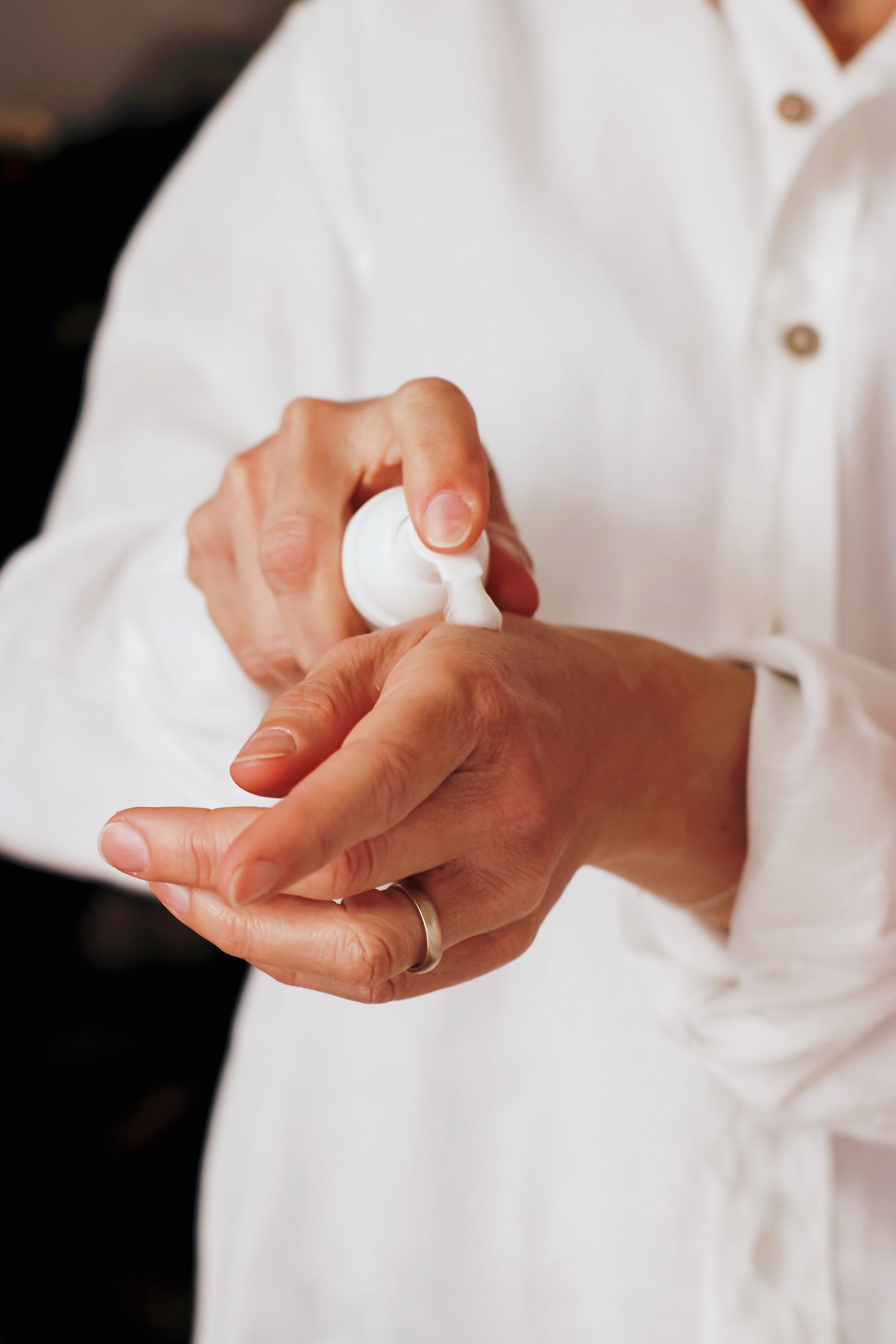
Rosacea & SPF: How To Choose The Right Sunscreen
Rosacea is a common skin condition characterized by facial redness and inflammation. Follow this guide to choose the right sunscreen if you have rosacea.
By SunsolveMD Team | 8 Min. Read
January 5, 2023Rosacea is a common skin condition characterized by facial redness and inflammation. It is characterized by facial erythema, telangiectasia, erythematous papules, pustules, and flushing, among other manifestations.
How does rosacea feel on the skin?
It often begins with a tendency to blush or flush more easily but can cause more than redness: skin dryness, edema, stinging, itching, and burning sensations.
While the exact cause of rosacea is unknown, some studies suggest that exposure to ultraviolet (UV) radiation may play a role in the development and progression of the condition. When UV radiation comes into contact with the skin, it can cause inflammation and damage to the skin cells.
Understanding UV radiation
It is important to have a detailed understanding of how exactly UV radiation affects the skin as it is one of the most frequently reported triggers of rosacea. The tendency of this disorder to affect the central face is influenced by the exposure of convex surfaces of the face to UV light. Lifetime UV radiation exposure has been shown to be significantly associated with the presence of rosacea and this is why avoiding exposure to UV radiation is a key part of managing the condition.
Based on their wavelengths, UV radiation is classified into three primary types: ultraviolet A (UVA), ultraviolet B (UVB), and ultraviolet C (UVC),. Almost all of the UV radiation that reaches earth is UVA although all types affect health but the UVA penetrates deeper into the skin and is more constant throughout the year.
UVA radiation has significant angiogenic properties and can upregulate the expression of vascular endothelial growth factor, and increase endothelial cell proliferation within existing blood vessels, leading to telangiectasia and resulting in facial redness and visible blood vessels.
UV irradiation can induce an imbalance between oxidant and antioxidant pathways leading to increased serum peroxide which causes increased inflammation and decreases levels of superoxide dismutase (SODs) - a key cellular antioxidant enzyme.
We know that UV radiation produces reactive oxygen species (ROS), the so called free radicals, responsible for inducing the release of pro-inflammatory cytokines and keratinocytes. The level of free radicals (ROS) are higher in patients with rosacea and ROS can increase inflammatory response in these individuals.
For the reasons listed above, avoiding exposure to UV radiation is a key part of managing the condition. This includes wearing a broad-spectrum mineral sunscreen daily with an SPF of at least 30 whenever outdoors, even on cloudy days.
It’s important to find a sunscreen with sufficient UV protection and rosacea-friendly ingredients, and to understand which ingredients to avoid as preservatives and fragrances in some products can cause a rosacea flare-up. If you have rosacea, it’s best to steer clear of chemical sunscreens. Ahead you will learn more about the differences between mineral and chemical sunscreens.
Keep reading to learn more on the importance of choosing the right sunscreen.
Mineral sunscreens
Mineral sunscreens or physical sunscreens are especially beneficial for those with skin conditions such as rosacea, as they are gentle, non-irritating, and provide a physical barrier against the sun’s rays. Mineral sunscreens contain active ingredients such as titanium dioxide or zinc oxide, which reflect the sun’s UV rays away from the skin rather than absorbing them like chemical sunscreens. This makes them ideal for those with sensitive skin, as they are less likely to cause a reaction. In addition to being gentle on the skin, mineral sunscreens are well-suited for those with rosacea due to the fact that they are non-comedogenic. This means that they won’t clog the pores and cause further irritation to the skin.
Ingredients to look for:
Zinc oxide
The most common hero ingredient used in mineral sunscreens. It remains on the skin’s surface, forming a coating that functions as a protective agent against the harmful effects of UV radiation. Being both antimicrobial and non-comedogenic (non-pore clogging) makes it a great choice for people with redness, rosacea and in general extremely sensitive skin. The best option is sunscreen that contains non-nano zinc oxide which is safer for your body and the environment.
Niacinamide
This powerhouse form of vitamin B helps renew and restore the surface of dry skin against moisture loss and dehydration. Calming niacinamide decreases the redness associated with rosacea.
Hyaluronic acid
A highly moisturizing and gentle ingredient helps rosacea prone skin to draw and retaining moisture. Plumps up skin cells for a healthy glow and improves skin elasticity.
Because the skin barrier is compromised when it comes to rosacea, the goal is to use gentle products that won't irritate the skin. The best approach is to strengthen and calm this skin barrier as much as possible with ingredients that have calming properties like lavender, oatmeal, chamomile, and licorice.
While mineral sunscreens are an excellent way to protect our skin from the sun, there is one major downside: they often leave a white cast on the skin. This white cast is caused by the minerals reflecting the sun’s rays, and it can be particularly noticeable on those with darker skin tones.
Fortunately, the new generation of sun protection technologies is offering solutions to this problem. They are highly effective, lightweight and transparent for a more inclusive coverage without the white cast.
SunsolveMD Ultra Calming Mineral SPF50: a nourishing, rich mineral SPF formula visibly corrects the look of skin redness and contains anti-redness complex for a calming, restorative effect to the skin.
SunsolveMD Cera-Soother TechnologyTM: targeted anti-inflammation technology designed to soothe the skin's barrier at the lipid level.
TheSolveTM: patented zinc (non-nano) technology provides a broad-spectrum SPF 50+ and shields the skin from 98%+ of UV radiation.
Ingredients to avoid:
Para-aminobenzoic acid (PABA)
Sunscreen ingredient rarely used since the 1990s because of strong potential for sensitising reactions.
Fragrance, even if it’s labeled as “natural”: fragrance-free sunscreens are best indicated for those with intolerant skin, or those who have sensitivities to fragrances.
Alcohol
Products that contain ethanol, methanol, ethyl alcohol, denatured alcohol, isopropyl alcohol, SD alcohol, and benzyl alcohol, “especially if these are listed high in the ingredients, as they can pose a problem for dry skin.
4-methylbenzylidene camphor: a UV filter that can cause toxicity and hormone disruption.
Chemical sunscreens
While chemical sunscreens are popular for their ease of use and long-lasting protection, they can also be a major source of irritation for those with rosacea. Chemical sunscreens work by absorbing UV radiation and converting it into heat. This process creates a reaction that can be very irritating to sensitive skin, and can cause flare-ups of rosacea.
Ingredients to avoid:
Avobenzone
The main ingredient in chemical sunscreens. Degrades when it is exposed to the sun which results in harmful free radicals being released into the body. Often cause skin allergies and hormone disruption.
Oxybenzone
Often found in sunscreens with Avobenzone. Because it is so easily absorbed into the skin and can penetrate to the deepest layers it can lead to harmful side effects. Oxybenzone interactions with other chemicals can cause changes deep in the skin, producing oxygen radicals that can lead to cell death.
Octocrylene
Octocrylene breaks down into Benzophenone, a hormone disruptor and potential reproductive toxicant. It readily absorbs through the skin at levels about 14 times the FDA limits and causes relatively high rates of skin allergies.
Homosalate
This ingredient is used due to its potential for fast absorption. The proble is it breaks down in our bodies faster then we are able to dispose it. As a result, it has a risk of becoming toxic and can disrupt estrogen, androgen and progesterone levels.
Other ways to protect your rosacea prone skin from UV rays
Wear a hat
Make sure the hat has a wide brim or visor to shade your face. A sun umbrella might also be a good investment if you plan to be out for an extended time.
Limit peak exposure
If possible, avoid being in direct sunlight from 10 a.m. to 2 p.m. Plan outdoor activities and exercise for when the sun is not as intense.
Stay cool
Remember to stay hydrated by taking along a water bottle. Chewing on ice chips also helps, especially with flushing.
Wear sunglasses
Sunglasses protect your eyes from UV rays and reduce the risk of cataracts. They also protect the tender skin around your eyes from sun exposure. Sunglasses that block both UVA and UVB rays offer the best protection.
Avoid tanning beds and sun lamps
Many people believe the UV rays of tanning beds are harmless. This is not true. Tanning lamps give out UVA and usually UVB rays as well. Both UVA and UVB rays can cause long-term skin damage, and can contribute to skin cancer. Tanning bed use has been linked with an increased risk of melanoma, especially if it’s started before age 30. Most skin doctors and health organizations recommend not using tanning beds and sun lamps.
Choose a broad spectrum sunscreen
Even with a high SPF if a sunscreen isn't broad spectrum, you won't be protected from all UV rays. Make sure it is water resistant and has at least SPF of 30 or higher.
References
Daniel Morgado-Carrasco MD, Corinne Granger MD, Carles Trullas MSc, Jaime Piquero-Casals MD, Impact of ultraviolet radiation and exposome on rosacea: Key role of photoprotection in optimizing treatment, 24 February 2021, https://doi.org/10.1111/jocd.14020
Laura Bedosky, The Difference Between Chemical and Mineral Sunscreen, July 21, 2021. https://www.everydayhealth.com/skin-beauty/chemical-vs-mineral-sunscreen-whats-difference/
Jessica Brown, Sunscreen: What science says about ingredient safety,
23rd July 2019. https://www.bbc.com/future/article/20190722-sunscreen-safe-or-toxic
